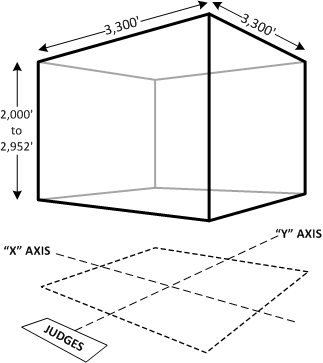
What’s most important for the purposes of this tutorial are the two lines in Figure 1 labeled “X Axis” and “Y Axis.” Depending on the contest site, the aerobatic judges might sit on any of the four sides of the box, but wherever they sit, the imaginary line which is parallel to their line-of-sight is called the “Y” axis and the line which is perpendicular to the judges’ line-of-sight is called the “X” axis. During a competition flight, except during turns, the airplane must always be aligned with either the X or Y axis. Why is that fact pertinent to a discussion about constructing Aresti figures? Because which axis the airplane must be aligned with, and in the case of the X axis, which direction the airplane must fly, is set by how the figure is drawn.
With that background, we are ready to start drawing a real figure. To illustrate the process, let’s use figure 1.2.3.1 from Family 1 of the Aresti Catalogue. It looks like this:

Recall that the dot indicates the beginning of the figure and the short cross-line the end. The half curved line on the 45° up line is the mandatory 180° attitude change symbol, and the full curved line with the double hash mark is the optional vertical roll symbol. Because it is ‘optional’ when drawing the figure we can choose to put a roll on that line or not. Once the figure is drawn, the pilot does not have any option. They must fly the figure as drawn.
Both of those curved roll symbols are called “unspecified rotations” because they are in the Catalogue to indicate a roll either must or may, depending on the symbol, go on the figure at the point, but they say nothing about what kind of roll or how much rotation will be used in the final drawn figure.
A very important point to make here is that once a figure transitions from the Catalogue to an actual aerobatic sequence, how the figure is drawn determines the axis on which the figure must begin and end, and, if on the X axis, in which direction it must be entered and exited. Recalling that the X axis is the line perpendicular to the judges’ line-of-sight (airplane flying left to right or right to left in front of the judges), Figure 2, as you see it above, must begin flying left to right, and must exit flying to the judges’ left. Exactly how you would think based on common sense.
Because the unspecified vertical roll symbol is optional, let’s choose to draw our first figure with no roll at all on the vertical line. That leaves us with the unspecified, mandatory 180° attitude change symbol on the 45° line. It is ‘mandatory’ because we must put a roll or rolls there to change the airplane’s attitude to match the character of the line. But how do we tell the pilot exactly which roll to fly at that point? That question brings us to the task of learning the next three ‘words’ of the Aresti language.

